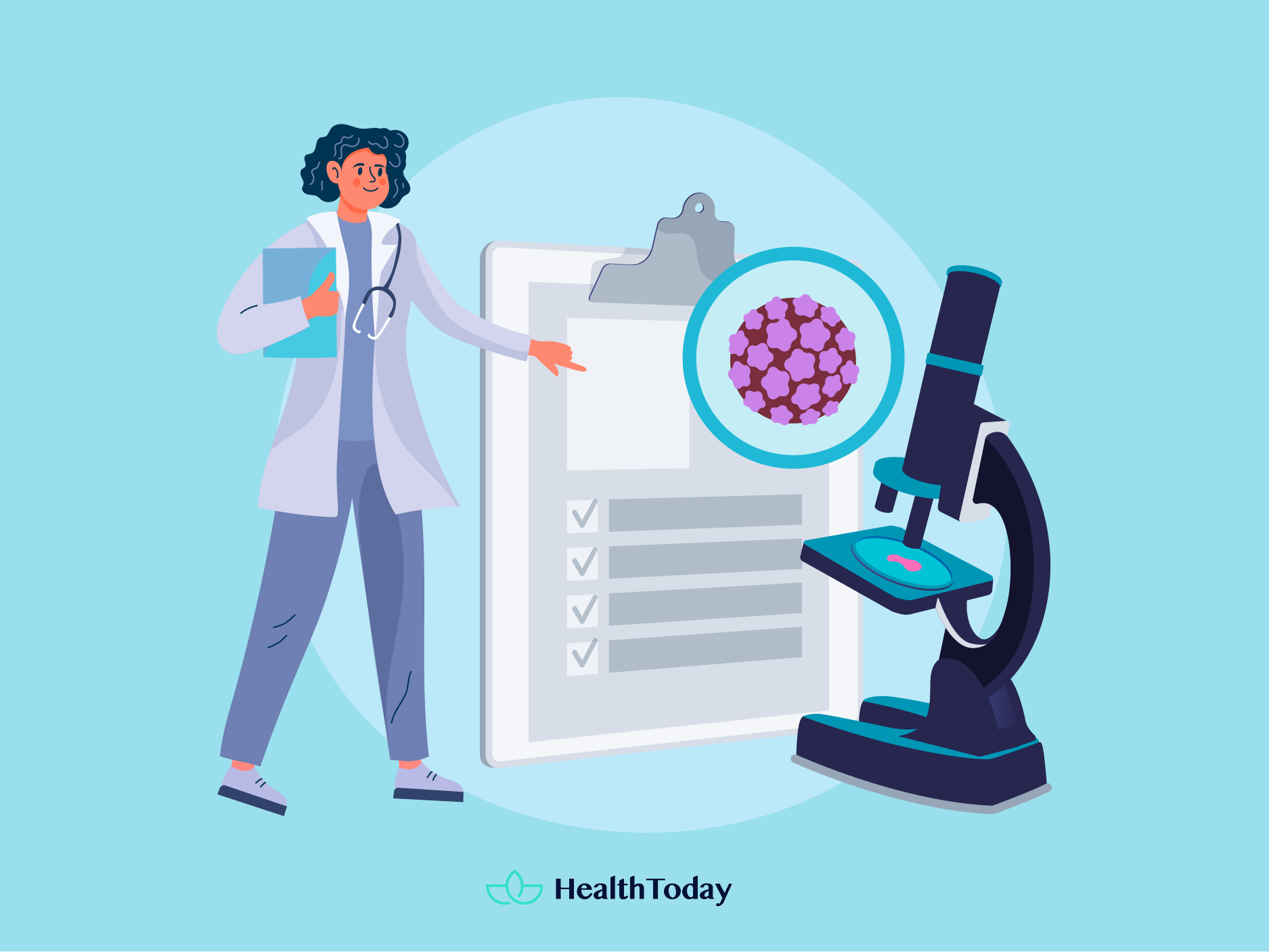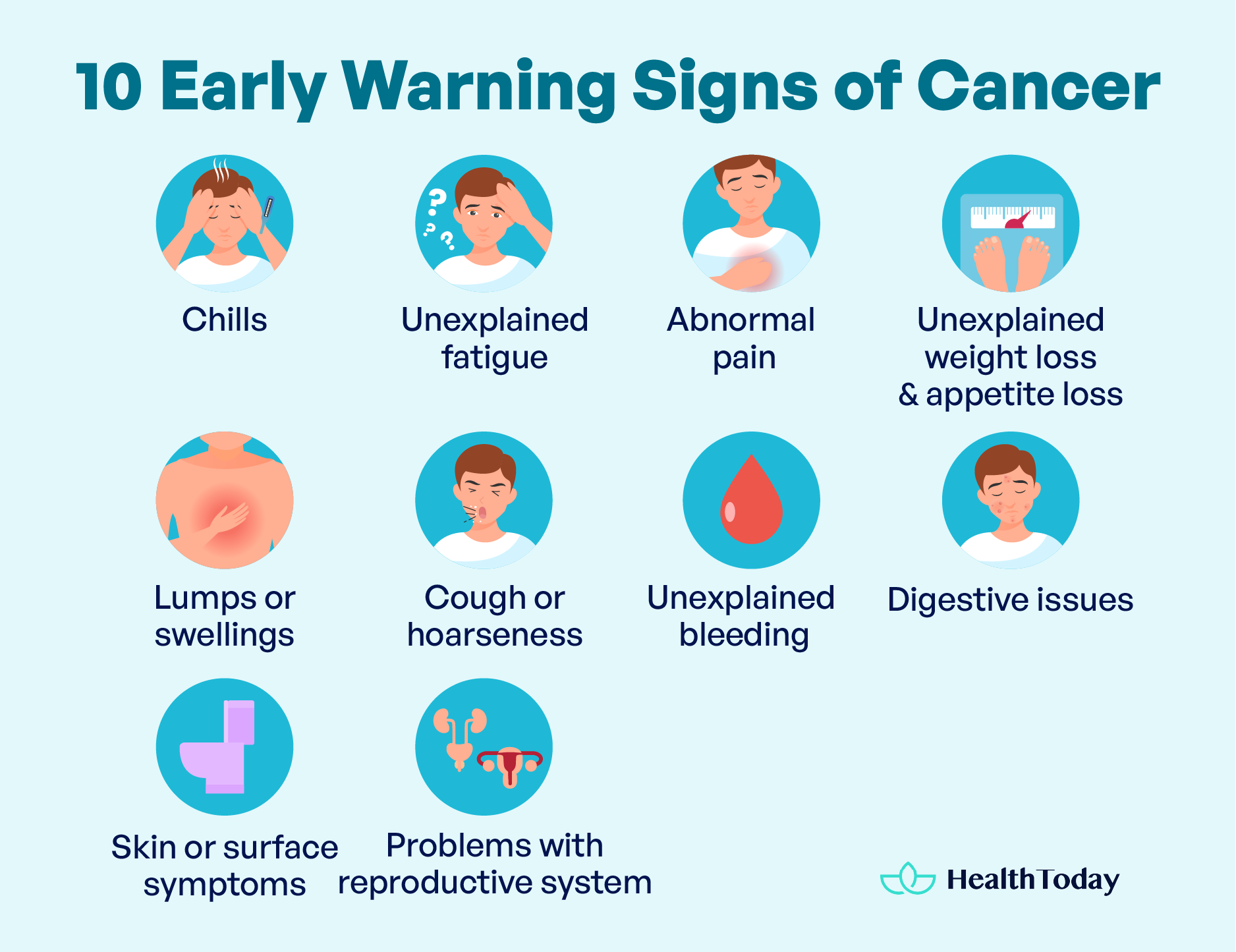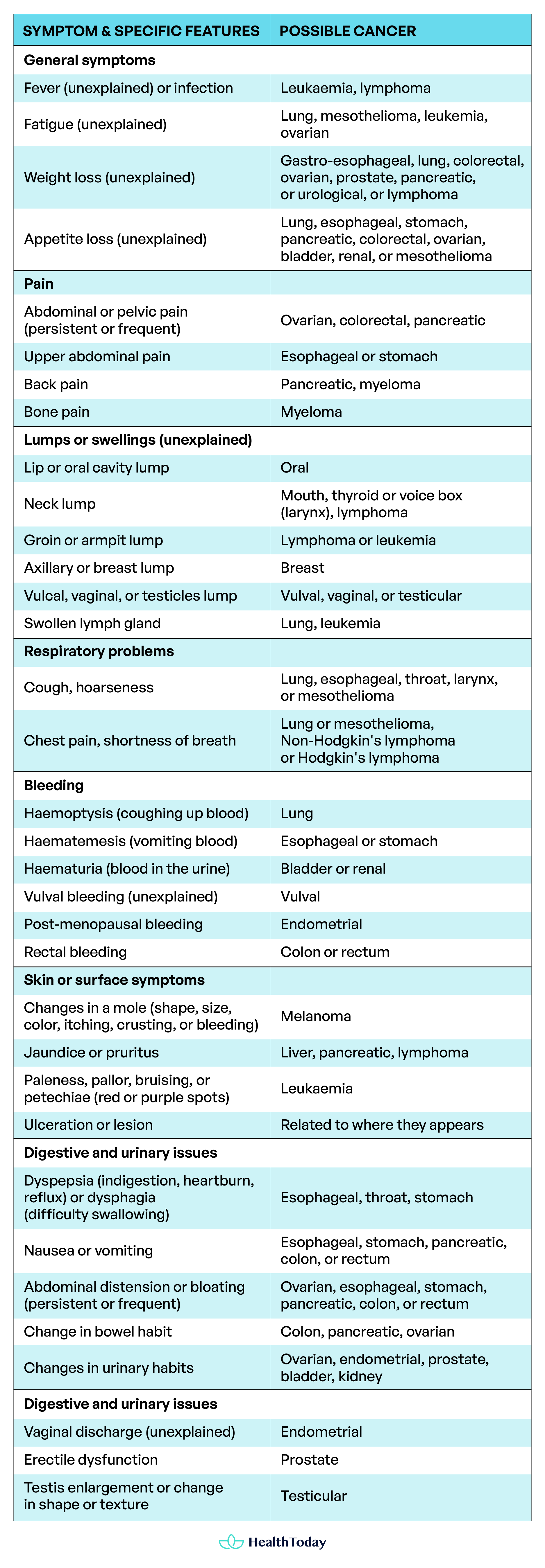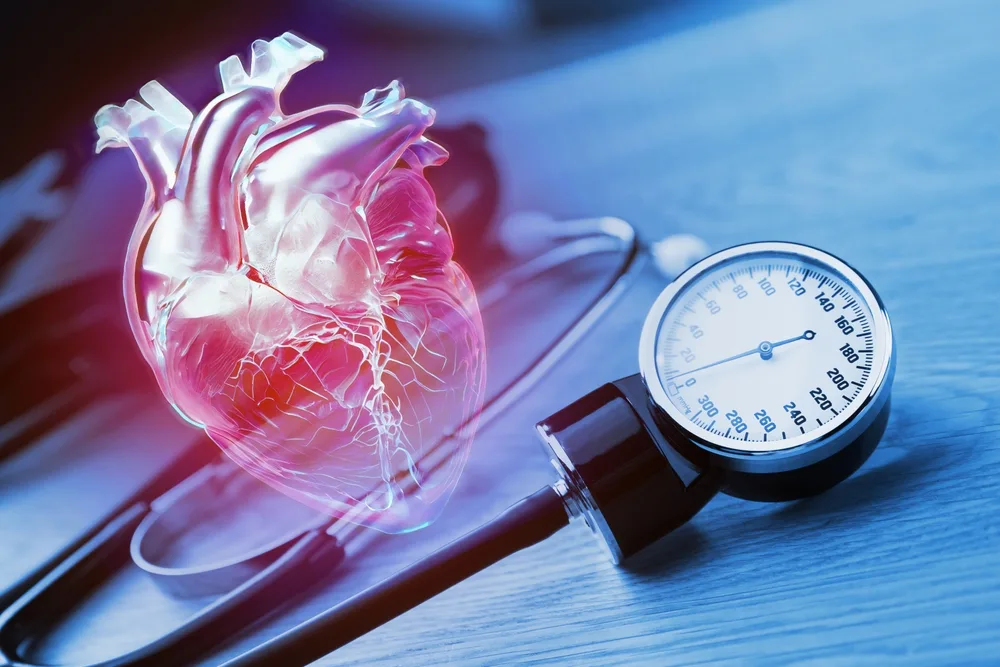Table of Contents
How long can you have cancer without knowing it? Timing is crucial in the battle against cancer, but cancer is often a silent intruder that goes unnoticed for a long time.
In this article, we will reveal the top 10 warning signs of cancer in your body. Also, how long does cancer diagnosis take? Let’s dive right in!

How long can you have cancer without knowing? Hidden cancer symptoms
The rate at which cancer develops and becomes noticeable depends solidly on the type of cancer and individual differences. So, there’s no fixed timeframe for tumor growth.
Can you have cancer for years and not know it? The answer is a solid yes: cancer often develops slower than one might think (1, 2).
How long can cancer grow undetected?
Cancer happens because of changes in our genes (i.e., DNA) caused by (3):
- Errors when cells divide
- Damage to DNA from carcinogens like asbestos, tobacco smoke, and UV rays
- Genes passed down from our parents
A cell needs a combination of genetic mistakes to become cancerous. These mistakes accumulate over time. When the right combination of mistakes occurs, they can cause cells to grow abnormally, which is cancer. Your body also has built-in safety mechanisms to eliminate and repair cells with damaged DNA, so it may take years to develop cancer (2, 3).
A 2011 model based on ovarian cancer found that a tumor could grow for over 10 years to reach the size of an olive before a blood test could detect biomarkers (4).
It can take about eight years for a lung tumor to reach a size of 30 mm when it’s typically diagnosed by radiological imaging (5).
Research has also shown that most breast and bowel cancers start growing about ten years before detection. Prostate cancer can be even older, with some very slow-growing tumors estimated to be around 40 years old (2).
Even cancers that seem aggressive, like pancreatic cancer, might have a slow and invisible development phase before detection (2).
How does cancer grow?
Cancer is typically divided into stages from I to IV (1, 6):
- Stage I is early-stage cancer that hasn’t grown deep or spread.
- Stages II and III involve cancer that has grown into nearby tissues or lymph nodes.
- Stage IV, called advanced cancer or metastasis, means the cancer has spread to other organs or parts of the body.
Before reaching stage I, Stage 0 develops when a cell becomes a tumor but is not yet cancerous. The tumor is still in its place of origin and hasn’t spread. For example, in bowel cancer screening, for every cancer found, four early tumors called adenomas are detected, with most adenomas not progressing to cancer (2). In Breast Cancer, stage 0 is called Ductal Carcinoma In Situ (DCIS), which accounts for 20 to 25 percent of Breast Cancers diagnosed by mammography in the United States (7). Anywhere between 36 and 100 percent of DCIS will progress to invasive breast cancer without treatment (42).
For a long time, it was widely believed that fast-growing tumors were more likely to spread (i.e., metastasize) and become deadly compared to slow-growing ones (8).
However, a 2017 study analyzing breast, cervix, and large bowel cancers found no proof that fast-growing cancers are more prone to spreading, nor that they are deadlier or reach advanced stages. Rapid growth and metastasis are the result of complex molecular processes, and they may not be closely linked (8).
Finding cancer early by getting regular screenings and noticing unusual symptoms can help find it sooner and when it’s easier to treat, no matter how fast it’s growing.

Asymptomatic cancer
Detecting cancers early can be challenging. There are no regular checkup rules for some cancers, and symptoms might not appear until the cancer is advanced (9).
Cancer that has no symptoms is also called asymptomatic cancer. How do people find out they have cancer in these cases? Doctors can discover asymptomatic cancer by chance during routine checkups, screenings, or while looking into other health issues. That’s why regular checkups, yearly physicals, and screenings are crucial (10, 11).
Some types of cancer with no symptoms are:
- Pancreatic cancer: The pancreas is located deep inside the body, making it hard to notice in its early stages, even during regular checkups (11, 12).
- Lung cancer: Early-stage lung cancer is often symptom-free. Approximately 80 percent of lung cancer patients have stage III or IV (advanced) disease when diagnosed (5).
- Colon cancer: Cancers related to the bowel can often have nonspecific symptoms, like bloating or constipation, and can be challenging to detect in the early stages (13).
- Prostate cancer: Early prostate cancer usually causes no symptoms (14).
- Bladder cancer: Patients don’t show any symptoms or have vague symptoms that can be similar to other illnesses (15).
- Kidney cancer: In the early stages, kidney cancers typically don’t show any signs or symptoms (16).
Can you have metastatic cancer with no symptoms?
Cancer often shows no noticeable symptoms in its early stages. Yet even in the advanced stages of metastatic cancer, patients may still not notice any symptoms or overlook them (18, 19, 20).
Small, isolated metastases (early stages) may not produce noticeable symptoms, while larger or multiple metastases are more likely to cause symptoms. Some examples of isolated metastasis cancer with no symptoms are the breast, brain, skeletal muscle, and colon metastases (21, 22, 23, 24).
If the patient has other health conditions, they can mask or complicate the symptoms of metastatic cancer. How to know if cancer has spread? Screening tests, biopsies, endoscopies, and imaging studies, such as computed tomography (CT) scans and magnetic resonance imaging (MRI), may help detect metastases before symptoms occur (10, 25).
While cancer screening can be frightening, it’s essential, especially if you have risk factors for specific cancers or cancer runs in your family (or more than two of your close relatives, like parents or siblings, have a history of cancer). Early detection can significantly improve long-term outlook (10,17).
10 early warning signs of cancer
In the early stage, cancer can cause symptoms in specific body areas, like lumps, bleeding, or pain where the cancer is. It can also lead to general symptoms like tiredness, fever, and weight loss (10).
Most signs and symptoms don’t mean you have cancer; they can be caused by other reasons (26). Yet, consulting a GP for investigation is vital for better treatment if cancer is present (17).


Are chills a sign of cancer?
Chills alone are not typically a direct sign of cancer. Chills, often accompanied by shivering or feeling cold, can be caused by fever, infections, or cold temperatures (27). But a cold that won’t go away can arise from cancer.
Can cancer cause a fever? The answer is a resounding “Yes” (26). Cancer can weaken the immune system, making one more susceptible to infections and fever (28).
Fever can also be a sign of non-cancer-related illnesses (29), but pay close attention if (11, 30):
- You consistently get a fever, primarily during the night.
- You don’t have any other signs of an infection.
- You often have night sweats.
Unexplained fatigue
Some cancers may have less obvious symptoms. Feeling tired persistently, which doesn’t get better with rest, is among the commonly missed signs of cancer (26, 29). For example, fever is possibly linked to lung and ovarian cancer, mesothelioma (affects the mesothelium), and leukemia (affects the bone marrow and blood) (30).
Fatigue could happen because cancer cells use up much of the body’s energy (26). If you consistently feel extremely tired and unwell without a clear explanation, it’s important to consult your primary care provider (17).
Moreover, unexplained neurological symptoms like headaches, balance, memory, and thinking, along with pain and fatigue, can be signals of brain or central nervous system cancer (10).





Do tumors hurt?
Are tumors painful? Yes, whether it’s a constant dull ache or an intermittent sharp pain (17). Unexplained pain that sticks around or gets worse, especially if it’s new and unexplained, can be a cancer alert (26, 30).
Cancer can lead to pain through (11):
- Pressure from a tumor pressing on nearby tissues
- Chemicals released by the cancer itself
- Metastasis
If you’re unsure about the cause of any pain in your pelvis, abdomen, or back, it’s important to consult your general practitioner (GP) or primary care physician (1). They can be early alarms for cancer of the oesophageal, stomach, pancreatic, colorectal, or even ovarian (10, 30).
Pain during urination can be indicative of bladder, kidney, or prostate cancer (30).
If you’re 60 or older and you have long-lasting bone pain, especially in your back, or you’ve had a fracture that wasn’t due to an accident, they can be noteworthy hints of cancer myeloma. Myeloma is a type of cancer that affects white blood cells and the bone marrow, where blood cells are made (10, 30).
Unexplained weight loss and appetite loss
Unexplained weight or appetite loss is a common early warning sign of cancer, especially if your doctor can’t find another explanation (10,26).
Significant weight loss (more than 10 pounds or 5 kg) in the past few months, unrelated to diet, exercise, or stress, may signify gastro‑oesophageal, lung, colorectal, ovarian, prostate, pancreatic, or urological cancer, or lymphoma (affects the lymphatic system, including lymph nodes, lymphatic vessels, the spleen, and bone marrow) (17, 26, 30).
Unexplained loss of appetite may point to underlying cancer, including lung, oesophageal, stomach, pancreatic, colorectal, ovarian, bladder, or renal cancer, or mesothelioma (30).
Lumps or swellings
If you notice any lumps or swelling that don’t go away, don’t ignore them: they can be cautionary cancer signs (29).
Lumps or swellings in the neck and mouth can result from mouth, thyroid, or voice box (larynx) cancer and lymphoma. Swollen lymph glands in other parts of the body, not just the neck, might be a sign of leukemia and lung cancer (10, 30).
In addition to the presence of a breast lump, changes in breast tissue, such as dimpling, skin thickening, puckering, dimpling, or redness, can be indicators of breast cancer (26, 30). So can changes in your nipples, including nipple discharge or the nipple appearing to be pulled inwards (retraction or inversion) (10).
Swelling and pain in a leg due to a deep vein blood clot (known as deep vein thrombosis or DVT) can link to any cancer type. Lumps in your groin or armpit could be a manifestation of lymphoma or leukemia (10).
Lumps in or near your vagina or vulva are possibly associated with vaginal or vulvar cancer (4). Also, lumps in your testicles may indicate testicular cancer (17, 30).
If you’re a woman and feel a lump in your abdomen, be careful of ovarian cancer (10).
Cough or hoarseness
A persistent cough or hoarseness, which doesn’t improve over time, can be a warning sign of lung, throat, laryngeal, or esophageal cancer (10, 26, 30).
Consult a GP if you’ve had a cough for three weeks or more (17).
Bleeding
Consult a GP if you experience unexplained bleeding, including (10, 17, 30):
- Coughing up blood
- Blood in your vomit
- Rectal bleeding
- Blood in your urine
- Vaginal bleeding between periods
- Vaginal bleeding a year or more after menopause
Unusual bleeding or bruising for no known reason is an early warning sign of bladder cancer (15, 26). Post‑menopausal bleeding may occur due to endometrial cancer, affecting the womb lining (30).





Skin or surface symptoms
Changes in skin color, size, shape, and new skin lesions or sores that don’t heal might stem from skin cancers (31).
Consult a GP if you notice changes in a mole, such as uneven shape, color changes, itching, crusting, bleeding, increased size, or elevation from the skin. These changes, especially along with skin lesions, would indicate melanoma, a serious form of skin cancer (17, 32).
Yellowing of the skin and eyes (jaundice) or pruritus (itching) can be a sign of liver, pancreatic, or lymphoma cancer (10, 26, 30).
If you have bruising, pallor, petechiae (a skin rash with small red or purple spots), or unusual paleness in your skin, your GP may suspect leukemia (10, 30).
Digestive issues
Stomach problems like acid reflux, indigestion, or nausea can be related to many digestive diseases. That’s why these symptoms are among the commonly missed signs of esophagus cancer (10).
Difficulty swallowing (dysphagia) or indigestion (dyspepsia or acid reflux) may be indicators of esophageal, throat, or stomach cancer (26,30).
In women, persistent or frequent abdominal (belly) pain or bloating (especially more than 12 times a month) might be alerting signs of ovarian cancer (10). These symptoms, plus nausea and vomiting, can also be linked with esophageal, stomach, pancreatic, colon, or rectum cancer (10, 6).
If your bowel habits have changed for three weeks or more, including symptoms like these, consulting a GP is important (1, 17, 30):
- belly discomfort
- blood in your stool
- unexplained diarrhea or constipation
- a feeling of incomplete bowel movements
- stomach or anal pain
- loose, pale, or greasy stool
These symptoms might be red flags of colon, pancreatic, or ovarian cancer (30).
Changes in urinary habits or blood in the urine may indicate ovarian, endometrial, prostate, bladder, or kidney cancer (10, 30). Possible changes are nighttime or pain while passing urine, blood in urine, changes in how often you urinate, or difficulty emptying the bladder (26, 30).
Problems with the reproductive system
In women, unexplained vaginal discharge can be a cautionary endometrial cancer sign (30).
In men, trouble getting an erection (erectile dysfunction) can be a symptom of prostate cancer. Also, testicles that have changed in shape or feel may be related to testicle cancer (30).
Symptoms in children and young people
Cancer in children (less than 15 years) and young people (less than 24 years) can be quite different from cancer in adults (10).
Neuroblastoma (starts in immature nerve cells), retinoblastoma (occurs in the retina), and Wilms’ tumor (affects the kidney) are those cancer types that mainly affect young children under 5 years old (10).
Common warning signs of cancer in children and young people are (10):
- Unexplained weight loss
- Fever and absence of red reflex in one or both eyes for retinoblastoma
- Weakness, balance issues, confusion, and tiredness
- Night sweats
- Lump or swelling in the abdomen, neck, armpits, or groin
- Shortness of breath
- Itchy skin, skin rash of small red or purple spots (petechiae)
- Blood in the urine
- Long-lasting bone pain
These symptoms can also be caused by non-cancerous conditions, but they should not be ignored. If your child shows symptoms that worry you, consult a GP or a specialist who can assess their health (4).


How long does a cancer diagnosis take?
There are over 200 types of cancer, and each one is diagnosed and treated differently (1).
When you suspect cancer, call your GP. They can perform blood tests, assess your condition, and give you personalized advice (10).
If your GP suspects cancer, they’ll refer you to a specialist. The expert will then assess your conditions quickly (17). Doctors may perform diagnostic and screening tests, such as imaging tests, endoscopy procedures, or biopsy and cytology tests, to evaluate your condition. Test results may be available within days to weeks (10, 18, 25).
In specific cases, they might do a blood test to check for leukemia (a type of white blood cell cancer). Note that most people referred to specialists don’t have cancer, but it’s crucial to get checked out promptly to be sure (10). If cancer is confirmed, treatment should start promptly (1).
Overall, it can take weeks to months to accurately diagnose cancer, but this usually won’t affect treatment effectiveness since cancer often develops slowly over many years (1).
Catching cancer early can significantly improve survival rates, while late-stage cancers often have limited treatment options. In the US, early-stage cancer has a 91 percent 5-year survival rate, compared to only 26 percent at a late stage (18, 33). So, follow your recommended cancer screenings and regular checkups (1).
When should you go to see a doctor immediately?
If you’re worried about cancer or experience any persistent, unexplained, or concerning symptoms, it’s important to see a doctor as soon as possible (10, 17, 34).
A symptom that warrants specialist evaluation immediately is unexplained petechiae (small red or purple spots that appear on the skin or mouth), especially in children and young people (less than 24 years old) (30).
If you are experiencing symptoms like trouble breathing or chest pain, it could be pneumonia (lung inflammation). In this case, it’s important to see a GP immediately (1, 17).
Chest pain or shortness of breath may also imply a heart attack or stroke, especially if you have any heart problems. Don’t hesitate to call 911 or your local emergency number right away to get help. Other warning symptoms are (35):
- Pain or discomfort in the arms, back, neck, jaw, or stomach
- Sweating, feeling nauseous, or feeling dizzy
- Face drooping on one side or feeling numb
- Arm weakness
- Speech that’s slurred or difficulty speaking





How long can you have pancreatic cancer without knowing?
It takes a long time—about 10 to 20 years—for pancreatic cancer to form in a person and can be diagnosed (36). However, once formed, pancreatic cancer is usually aggressive and can grow quickly, often within a few months after diagnosis (37).
Pancreatic cancer is tough to catch in its early stages because the pancreas is tucked deep inside the body. Usually, symptoms don’t show up until the cancer is quite big or has already spread to other parts of the body (12).
Where do I go if I think I have cancer?
The first step is to make an appointment with your primary care physician or general practitioner (GP). They can assess your conditions and determine if further evaluation, testing, or referral to a specialist is necessary (10).
A specialist might be an oncologist (cancer specialist), gastroenterologist (digestive system specialist), dermatologist (skin specialist), or other relevant medical professionals for diagnostic tests (10).
What are the early signs of cancer for men?
Common cancers in men are prostate, colorectal, lung, and skin cancers (38). Early signs of them include persistent cough, coughing up blood, hoarseness, moles, abnormal urine habits, blood in the urine or semen, erectile dysfunction, and pain or stiffness in the shoulder, lower back (spine), chest (ribs), hips, or pelvis (5, 13, 14).
Can cancer cause a fever?
Yes, cancer can sometimes cause a fever. Tumors can produce pyrogens, which can lead to fever. Pyrogens may be generated by the tumor or the body’s immune response to cancer cells. Also, cancer patients may have weakened immune systems, making them more susceptible to infections and fever (39).
Does cancer pain come and go?
Yes, cancer patients may have both continuous and intermittent pain, which come and go. The pain may be triggered by specific activities, movements, or conditions and subside when the underlying cause is relieved. Breakthrough pain refers to episodes of severe pain that occur despite ongoing pain management (40).
Summary
How long can you have cancer without knowing it? The time varies among cancer types, the patient’s overall health, and whether they undergo regular screenings. Cancers can exist for years or even decades before being found.
Cancers are easier to treat if caught earlier. So, following your recommended screenings and regular checkups, as well as noticing the early signs of cancer, can be crucial.
However, some symptoms, like weight loss and chills, may seem general, and certain cancers—including brain, pancreatic, lung, colon, prostate, and kidney—can be asymptomatic in early stages.

















Comments
0